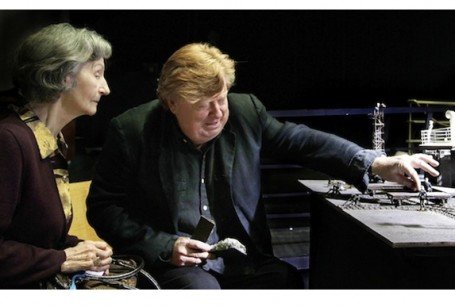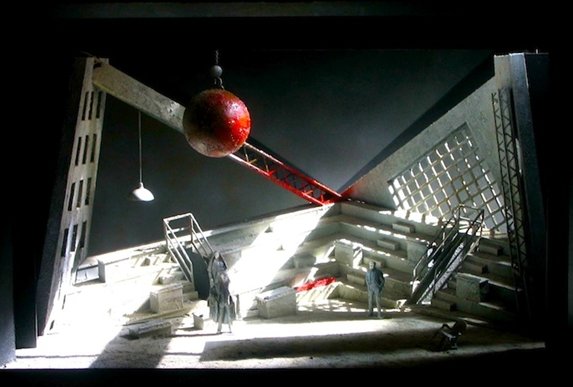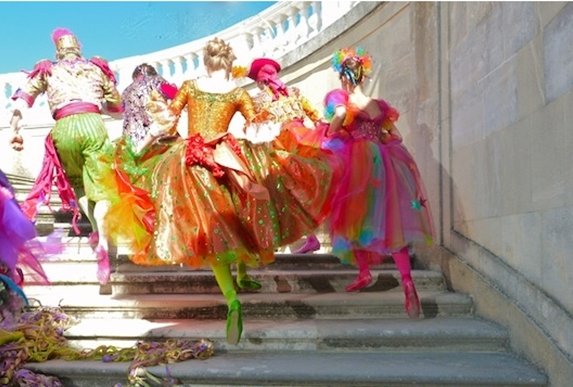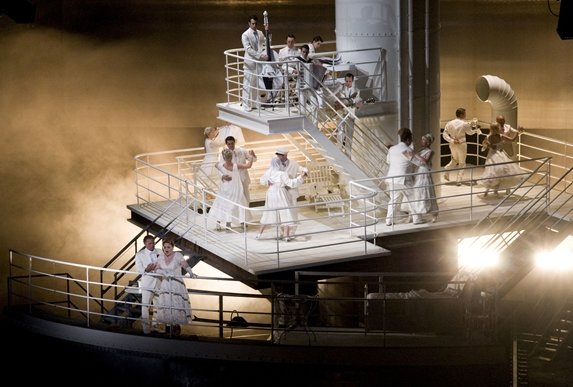Stage designer extraordinaire Johan Engels

Johan Engels has designed extensively for opera, ballet, and theater. After his studies in Fine Arts and Design at the University of Pretoria and he worked extensively for PACT, designing for Opera, Ballet and Theatre. Today he is one of the top international designers and his work has graced the stages of all the important opera houses around the globe. Recently this includes Faust for the Paris Opera; Weinberg’s The Passenger for the Bregenz Festival, Polish National Theater, and English National Opera; Thaïs for Gothenburg Opera, to be revived in Helsinki and Valencia; Il trittico, Hindemith’s Saint Susanna, and Schoenberg’s From Today to Tomorrow at Lyon Opera; Hindemith’s Matthias the Painter at Theater an der Wien; and Lulu for Welsh National Opera. In 2013 and 2014 Engels also will design the sets for The Magic Flute, for David Poutney’s production at the Bregenz Festival.
Please tell us more about Johan Engels, the person – where did you grow up, where did you go to school?
JE: I was born in Scottburgh on the south coast of Natal. I grew up in Durban and had my schooling at Port Natal. I loved drawing from a young age and exhibitions at Stuttafords - of Trechikoff’s work - fascinated me and made me draw lost orchids and roses, with tear shaped dewdrops, for months afterwards. I was obsessed by epic films and spent all my pocket money at the old Playhouse and Cinerama cinemas, losing myself in the world of Ben Hur, El Cid and all the other Bible epics of the fifties.
When did the “theatrical” bug bite you?
JE: I saw my first opera, La Traviata, at the Alhambra Theatre in Durban and when we moved to Pretoria the next year, Verdi’s Macbeth with Renato Bruson and Joyce Barker. Britten’s Peter Grimes with Gert Potgieter sealed my fate. After that I saw every opera and play put on by PACT Opera and Drama (Performing Arts Council of Transvaal), and started building miniature models of all the sets I had seen. I had only one dream - to become a theatre designer, and that was final!
As a young designer, who were your mentors?
JE: A brilliant young costume designer, Aubrey Couling, was designing most of the costumes for PACT’s operas and dramas at the time. His work was of a standard that still shines today. He was a born theatre artist with almost no training, but with a natural instinct and flair for what worked on stage. His work on Francois Swart’s King Lear and The Merchant of Venice and the operas La Traviata and Don Carlos was ground-breaking. He was killed tragically in a car accident at the age of 27 and South Africa lost a great talent. I was first shown his drawings by Neels Hansen, my then lecturer at the University of Pretoria, another huge personality in my theatre education, who taught me everything I know about the passion for the theatre and design.
Set design by Johan Engels for Khovanchina (Mussorgsky), directed by David Poutney.
Also Raimond Schoop, a German designer living in South Africa, was designing most of PACT’s Opera productions, including Frank Staff’s famous ballet Raka. He taught me an abstraction of reality that I admired greatly. But the 1970’s was a time of the neo-realism and it was from the hand of Richard Cook, the then resident designer at PACT that I learnt the most about set design. In later years the British designer Ralph Koltai became my mentor and a great influence, and I assisted him for many years.
You studied Fine Arts and Design at the University of Pretoria and worked extensively for PACT (Performing Arts Council) from 1975 – 1980, also designing some productions for the Market Theatre in Johannesburg. Did you then leave South Africa specifically to pursue a career overseas?
JE: I always loved to travel and as a result I left South Africa for a year’s sabbatical to go and observe at four opera houses of the world: Die Deutsche Oper Berlin, Glyndebourne Opera Festival, Bayreuth and the Royal Opera House Convent Garden, where I spent three months at each. It was an extraordinary eye-opener and experience for me. I had every intention to return to South Africa, but somehow things started to work out for me abroad and I stayed on.
How did you get your “break” in Europe?
JE: I first designed small opera productions in London with young up-and-coming directors like Nickolas Heytner, Robert Carsen, Michael Renisson and several plays at the Royal Exchange Theatre in Manchester, and the Royal Shakespeare Company (RSC) in Stratford. But it was when the then director of the RSC, Terry Hands asked me to design his farewell production of the Seagull at the RSC, that I was put on the map. I designed all Terry Hands’ productions all over the world for the next six years. Meeting David Pountney, the then Artistic Director of the English National Opera in 1998, was when my work with him in opera took off and this had an enormous influence on my work.
There are designers who believe that less is more. Your designs seem to lean towards “more is more”. What is your “philosophy” as designer, or does this vary from production to production?
JE: Every work of theatre or opera needs either more or less. The work dictates my style of “more-ness” or “less-ness”. A baroque opera by Thomas Arne, Artaxerxes, which I designed for the Royal Opera House, demanded an opulence and extravagance that suited its music and its subject. Terry Hands’ production of The Cherry Orchard in 2010 asked for nothing more than a vast empty bleached white space, onto which only hints of a cherry orchard and a sweeping Russian summer landscape could be suggested. I have no style that is recognizably mine. I allow each piece to impose on me, through its music or its text, a style for which I design only as much or as little as is necessary.
You are designing Die Zauberflöte for the Seebühne at the Festspiele in Bregenz in 2013. What are the challenges of designing for this huge outdoor venue?
JE: Bregenz is quite unique in the world as far an opera in the open air is concerned. It consists of an auditorium that seats 7000 people that faces a lake in Austria. Its history is one that has a reputation of having had the most extravagantly huge set designs done by almost every famous designer in the world. Ironically enough, only one or two designers have managed to successfully solve the myriad of problems this stage on the water challenges you with. Stefanos Lazaridis, with his designs for der Fliegende Holländer, Nabucco and Fidelio (with director David Pountney), managed to discover not only the correct scale of a design standing in nature, but also how to achieve scene changes with a set that in most cases is just a static sculpture in the middle of the lake.
The Magic Flute asks not only for Papagenos forest, The Queen of the Night’s domain and Sarastro’s Temple, but also for snakes, trials by fire and water, visions and above all Magic. To fit this all in on a watery stage is the greatest challenge I have ever been asked to tackle.
Costume designs by Johan Engels for New Year’s Concert in Vienna.
Have you decided on the look for the production?
JE: The Magic Flute will be my 30th production with artistic director David Pountney. We decided that for once we were going to tell the story of the Magic Flute as if for children. After all it is the work that introduces opera to most of German speaking children. So as it has its roots also in my childhood imagination, it is going to be a very African Magic Flute. With gigantic animals and a floating tortoise as a stage with an inflatable forest on its back, we will try and bring as much magic to the work as it rightly deserves. With the first ever revolving stage on the Seebühne, we will create scene changes that will bring forth snakes out of the depths of the lake, The Queen of the Night floating in the night sky and creatures and animals that will hopefully enchant both children and adults.
How important is experimenting with new materials for a designer?
JE: For me new materials open up new ideas and possibilities. I am constantly noting down what I see happening in industry and technology. They say that nothing in the theatre is new, which is in some way true, but new materials allow you to make the old ideas look new. Advances in lighting, theatre technology and computer science is there for you to use, but only as a tool to make your life easier. Because theatre magic still lies, and will always lie rooted in the audience’s imagination - it can make you believe that bundles of cane and leather straps are horses that can breathe, neigh and gallop on stage, and make you cry with them when they die at the end, e.g. in the wonderful production War Horse.
Set design for Maskerade by Carl Nielson, designed for the Bregenzer Festspiele and the Royal Opera House Covent Garden. Director David Poutney, costume design Marie-Jeanne Lecca, set desgin Johan Engels.
Multi-media productions have been en vogue for quite a while. Do you think that audiences are getting tired of this?
JE: In my opinion the stage is not the place for multi-media designs. That is called a cinema - with all its advanced multi-image widescreen and 3D technology. The theatre audience feels cheated when projections do not look as good as in an IMAX Cinema. The theatre is a place for the imagination. Shakespeare, in Henry V Part I, tells us in words what we should be imagining on stage and we do. Everyone in the audience’s imagination is more vivid than anything I can put before them. My function as a designer is to merely suggest the dots of an idea, which the audience, each in his own way and experience, join up to see what they want the image to be.
Do you think multi-media productions really attract younger audiences – often the reasoning behind these production designs are that the director would like the production to “speak” to the new generation.
JE: I believe that it is sadly a lack of originality and ideas that make directors believe that multi-media attracts younger audiences. It is a misguided group of usually older directors who think that this is what it takes to engage a younger audience. Our younger audiences have devoured Harry Potter, booked out the National Theatre in London for War Horse, with our own Handspring Puppet Company’s brilliant horses. Shakespeare has “spoken” to every new generation over four centuries and time and again proved his plays remain relevant and topical. If you engage a child’s imagination in whatever way possible, you will “speak” to them.
In South Africa budgets often force designers to become very “creative”. Do you find the same is starting to happen in Europe, or are budgets still of a scale that gives you as designer free reign?
JE: All over Europe theatre and opera is also suffering from the economic pressure. But it is not necessary a bad thing that we have to more careful and creative in approaching a design project. The days of lavish sets and costumes are over, and even audiences have become saturated by the excess, which left very little to the imagination. We all cut our teeth in the “poor” theatre, which now comes in very handy, when we have to find simpler and cleaner solutions to a design. But designers always get the blame. It is a fact that what the audiences see at an opera production constitutes only 17% of the entire budget of the production - but we are always the first to have to brave the cuts.
What has been the most challenging design you have had to do up to date?
JE: David Poutney’s production of Mieczylav Weinberg’s “The Passenger” - premiered at the Bregenz Festival in 2010 - was the world premiere of a long neglected opera, set partly in Auschwitz concentration camp. The author of the disturbing story Zofia Posmysz, who had been a prisoner in Auschwitz for four years, is still alive. Firstly, it is impossible to put Auschwitz on stage; one can only suggest its horrific presence. Secondly, how was I to design a set for a production that will have Zofia Posmysz present in the audience?
Once I had completed the design, I asked to present it to her alone (photo top), only with the presence of our Polish interpreter. I had never been so nervous in my entire life. When she saw the model, she started to cry. When I asked her why, she replied that even though there was nothing specifically Auschwitz about it, the space reminded her of its horrors. That was the biggest compliment I could ever have expected. Already performed in Bregenz, Warsaw and London, The Passenger travelled on to Houston, New York, Chicago, Tel Aviv and Copenhagen and is by far the most powerful work I have ever had the privilege to be associated with.
Set design for Die Passagierin by Johan Engels. Director David Poutney. (Bregenzer Festspiele 2011)
Of all the productions you have designed, which one has been your personal favourite?
JE: There are several, and usually they are the productions where the teamwork between actors, singers, designers and director were in perfect unison. Under these I must count my two Chekov productions with Terry Hands and Turandot (Salzburg), The Passenger (Bregenz) and Maskarade (Royal Opera House) with David Pountney.
What was the best advice you ever received as a designer?
JE: From Terry Hands from the RSC: “I hate designers who give me what I ask for.”
Interview by Christien Coetzee Klingler
Published 29.10.2012
|
Related Entries |
<< Back to Focus On << Back to All Features |











